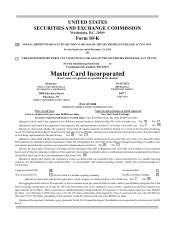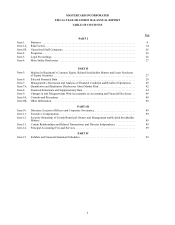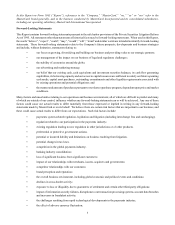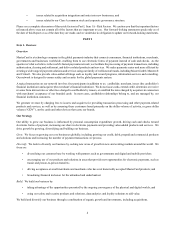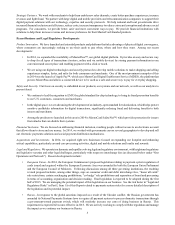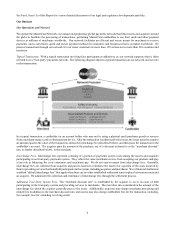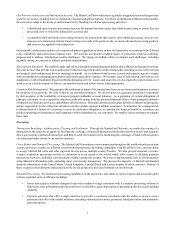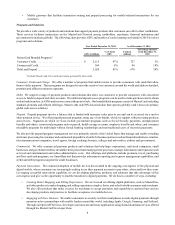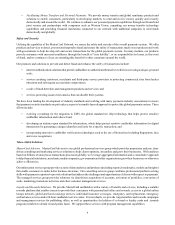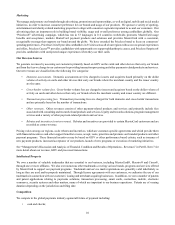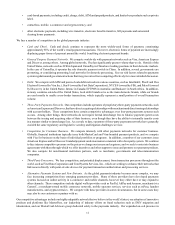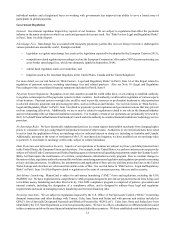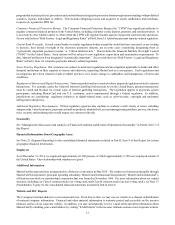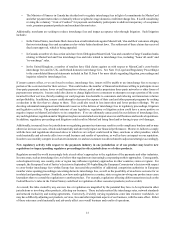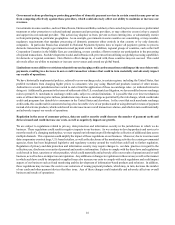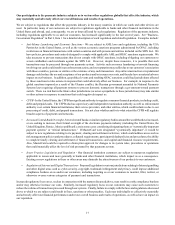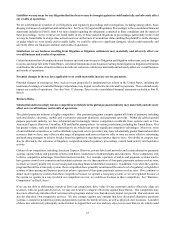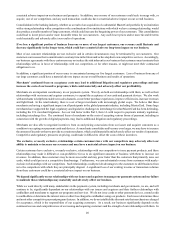MasterCard 2014 Annual Report Download - page 13
Download and view the complete annual report
Please find page 13 of the 2014 MasterCard annual report below. You can navigate through the pages in the report by either clicking on the pages listed below, or by using the keyword search tool below to find specific information within the annual report.11
• card-based payments, including credit, charge, debit, ATM and prepaid products, and limited-use products such as private
label;
• contactless, mobile, e-commerce and cryptocurrency; and
• other electronic payments, including wire transfers, electronic benefits transfers, bill payments and automated
clearing house payments.
We face a number of competitors in the global payments industry:
• Cash and Check. Cash and check continue to represent the most widely-used forms of payment, constituting
approximately 85% of the world’s retail payment transactions. However, electronic forms of payment are increasingly
displacing paper forms of payment around the world, benefiting electronic payment brands.
• General Purpose Payment Networks. We compete worldwide with payment networks such as Visa, American Express
and Discover, among others. Among global networks, Visa has significantly greater volume than we do. Outside of the
United States, networks such as JCB in Japan and UnionPay in China have leading positions in their domestic markets.
In the case of UnionPay, it operates the sole domestic payment switch in China. In addition, several governments are
promoting, or considering promoting, local networks for domestic processing. See our risk factors related to payments
system regulation and government actions that may prevent us from competing effectively for a more detailed discussion.
• Debit. We compete with ATM and point-of-sale debit networks in various countries, such as Interlink®, Plus® and Visa
Electron® (owned by Visa Inc.), Star® (owned by First Data Corporation), NYCE® (owned by FIS), and Pulse® (owned
by Discover), in the United States; Interac in Canada; EFTPOS in Australia; and Bankserv in South Africa. In addition,
in many countries outside of the United States, local debit brands serve as the main domestic brands, while our brands
are used mostly to enable cross-border transactions, which typically represent a small portion of overall transaction
volume.
• Three-Party Payments Networks. Our competitors include operators of proprietary three-party payments networks, such
as American Express and Discover, that have direct acquiring relationships with merchants and direct issuing relationships
with account holders. These competitors have certain competitive advantages over four-party payments systems such
as ours. Among other things, these networks do not require formal interchange fees to balance payment system costs
between the issuing and acquiring sides of their business, even though they have the ability to internally transfer costs
in a manner similar to interchange fees. As a result, to date, operators of three-party payments networks have generally
avoided the same regulatory and legislative scrutiny and litigation challenges we face.
• Competition for Customer Business. We compete intensely with other payments networks for customer business.
Globally, financial institutions typically issue both MasterCard and Visa-branded payment products, and we compete
with Visa for business on the basis of individual portfolios or programs. In addition, a number of our customers issue
American Express and/or Discover-branded payment cards in a manner consistent with a four-party system. We continue
to face intense competitive pressure on the prices we charge our issuers and acquirers, and we seek to enter into business
agreements with them through which we offer incentives and other support to issue and promote our payment products.
We also compete for non-financial institution partners, such as merchants, governments and telecommunication
companies.
• Third-Party Processors. We face competition, and potential displacement, from transaction processors throughout the
world, such as First Data Corporation and Total System Services, Inc., which are seeking to enhance their networks that
link issuers directly with point-of-sale devices for payment transaction authorization and processing services.
• Alternative Payments Systems and New Entrants. As the global payments industry becomes more complex, we may
face increasing competition from emerging payment providers. Many of these providers have developed payments
systems focused on online activity in e-commerce and mobile channels, however they either have or may expand to
other channels. These competitors include digital wallet providers such as PayPal, AliPay and Amazon, merchants (via
CurrenC, a merchant-owned mobile commerce network), mobile operator services, services such as mPesa, handset
manufacturers, and cryptocurrencies. We compete with these providers in some circumstances, but in some cases they
may also be our customers or partner with us.
Our competitive advantages include our highly-adaptable network that we believe is the world’s fastest, our adoption of innovative
products and platforms like MasterPass, our leadership of industry efforts on fraud reduction such as EMV migration and
tokenization, and our MasterCard Advisors group dedicated solely to the payments industry. Our expanded on-soil presence in


